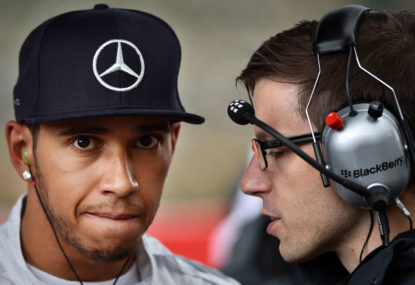Angry Carlos Sainz almost demands Oscar Piastri give back on-track spot after fierce battle
The Spanish driver claimed he was forced off the track while trying to overtake into fourth spot and wanted the McLaren driver to give…

“Please no!” Lewis Hamilton exclaimed in a post on his Instagram page, which has since been taken down. “This is the worst looking mod in Formula One history.”
Undoubtedly you have seen it by now. Dubbed the ‘halo device’ among the teams as a possible solution for increased cockpit protection, Ferrari ran a basic mock-up of what it imagines such a rig might look like.
The result, so succinctly summed by Lewis Hamilton, was less than beautiful. Possibly what grated most was that a far more aesthetically pleasing design was circulated last year, yet the first prototype has adopted none of the flowing lines that made the idea palatable.
To be fair to Ferrari, the crude structure was only superficial. It wasn’t at all functional, much less integral. Even if the maths on its design adds up and it’s ultimately adopted by the FIA, the end product would likely be at least partially removed from the image of 11 pairs of multi-coloured thongs racing down the pit straight Ferrari’s prototype evokes.
In short the halo design still has some way to go, and the divided opinion up and down the pit lane and in the homes of fans across the world is testament to this.
Whether it’s Nico Hülkenberg decrying the sterilising of the sport or Daniel Ricciardo shutting him down with accusations of unnecessary chest puffing, the claim and counterclaim of proponents and antagonists will occupy an increasingly significant part of the sport’s coverage. That’s until the FIA makes a call for the introduction of a solution in time for 2017.
Is it Formula One? Can Formula One still be Formula One if it is no longer open-cockpit racing? Is Formula One still truly open-cockpit considering how shrouded drivers already are in protective bodywork? What will the implications be for junior formulae less able to make such a change in the short medium term?
But among all these questions, already difficult to grapple with on their own, is whether this halfway house device is worth the trouble. Yes, it is additional protection not currently available to drivers, and yes, it has the potential to save a driver’s life from a flying tyre or other large piece of debris. However, are these types of accidents prevalent enough in the range of potential injurious accidents to say this device is a job well done? I’m just not sure it is.
The most recent serious accident involving preventable head damage at a grand prix weekend was a 700-gram spring detaching from Rubens Barrichello’s car and fracturing Felipe Massa’s skull at the 2009 Hungarian Grand Prix. The halo device is unlikely to have prevented such an accident.
Near misses include the 2013 British Grand Prix, when debris from a litany of exploding tyres flew past the heads of drivers on some of the quickest parts of the track. A halo device is, again, unlikely to have prevented injury.
When Formula One has become so safe that the accidents against which we are guarding can only be described as ‘freak’, will only partially covering a driver’s head really do? If the nature of a freak accident is one that cannot be expected, is it enough to develop a solution that critically alters the DNA of a modern Formula One car but still leaves room for something to go wrong?
It is good and right that the FIA should be investigating ways to protect a driver from injury, and for the better part of the last three decades this has been a key part of its governance of the sport.
It is also refreshing to see that teams are committed to helping find a solution and that their natural competitiveness is driving innovation. Red Bull Racing is set to trial its own proposal on a demonstration car later in the year, and undoubtedly others will follow.
But if Formula One is ready to fundamentally alter its closed-cockpit nature, why not opt for total protection? The FIA Institute has already tested jet fighter-style canopies, and adopting such a solution would allow the sport to borrow heavily from an already developed database of knowledge un the use of canopy materials.
A canopy is safer, a canopy is a design already proven in fields far more dangerous and extreme than motorsport, and, if we’re honest, a canopy looks better. If we’re talking long-term design trends, take one look at McLaren’s futuristic and canopy-centred concept car, the MP4-X and tell me it doesn’t look cool.
With the sport’s current thinking on halo protection – and admittedly it remains in its early stages despite its planned implementation next year – safety would take a mere shuffle into the future, but with a canopy it would be a proper Formula One-sized leap.
Follow @MichaelLamonato on Twitter in the lead-up to the #AusGP.